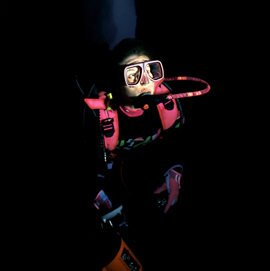Night Diving Primer
Posted: Aug 29 in Dive Blog tagged Specialty Diving by Jan Imagine yourself floating in water as inky black as the night sky. You wave your hand through the darkness and find it outlined by tiny, vibrant lights, as if the stars themselves are following your every movement. They disappear as you flick your dive light on, but you interrupt the serene blackness at the perfect time—a majestic sea turtle swims by just to your left, nearly close enough to reach out and touch.
Imagine yourself floating in water as inky black as the night sky. You wave your hand through the darkness and find it outlined by tiny, vibrant lights, as if the stars themselves are following your every movement. They disappear as you flick your dive light on, but you interrupt the serene blackness at the perfect time—a majestic sea turtle swims by just to your left, nearly close enough to reach out and touch.
Night diving lets you see any underwater world in a whole new way. A sweep of your dive light through the nighttime sea may reveal all sorts of creatures that seek refuge during the daylight hours: basket stars, lobsters, sea turtles, bioluminescent plankton and more. Your flashlight’s beam can expose mysteries you never imagined, even making the colors of the reef more radiant and intense.
If you’ve got your dive certification in Peoria and want to explore some of your favorite underwater environments in a new light, night diving is the perfect way to do it.
Though the best way to learn how to night dive properly is to take a night diver specialty class, here are a few basics of night diving to get you started.
- Carry a good light—and a backup. Of course, one of the bare essentials for a night dive is a proper dive light. Try to find one with an intense beam and long battery life. Some night divers advise using a light that sinks instead of floats—that way, you can put it down without it rising back to the surface. However, you should always attach your light to your wrist with a lanyard so that it does not get away from you and the sinking or floating debate becomes far less of an issue. You’ll also need a backup light in case your primary light fails. Your backup light can be a smaller so that it fits in your BCD pocket out of the way, but should still be powerful enough to light the way if you need it. Remember to test both lights and use fresh batteries even if you don’t plan on using your backup light.
- Dive only where you’ve been. Diving somewhere in the daytime will help you get an idea of what to expect at night. If you night dive somewhere you’ve never been before, you won’t know to avoid a dangerous drop-off and may increase your chances of getting lost underwater. Because night diving has its own unique risks, you should only pick a location that you know you’re skilled enough to handle. However, even in familiar places, you’ll be amazed by how new everything seems.
- Start at dusk. Darkness is what you want for a great night dive, but full darkness can make it difficult to get your gear on and make your entry. Try to start your dive while you still have a little bit of daylight and let yourself gradually adjust to the darkness while underwater rather than plunging into it straight from the start. As an added bonus, you may be lucky enough to see some underwater wildlife show off some unique twilight behaviors as they bed down or get ready for nighttime feeding.
- Find new navigation guides. No matter how familiar you are with a dive spot, you’ll lose many familiar navigational points of reference at night. You’ll need to find new visual cues beyond the ones you use during the day, like lights on the shore or a mark on the boat’s anchor line. Of course, you should also be well-versed in underwater navigation and have a compass to guide you.
Have you tried night diving? Share your experiences with us in the comments below.
